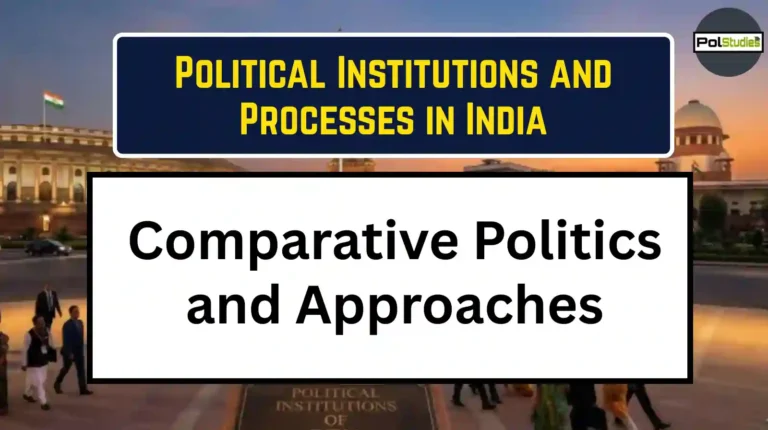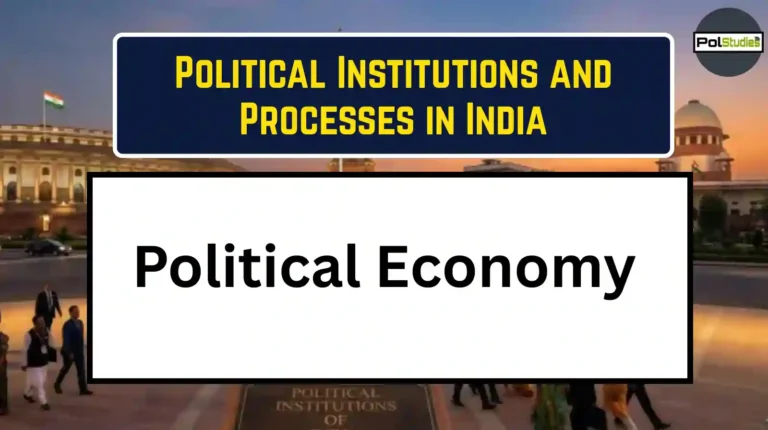Rise of the Indian State from the Pre-colonial State to the Modern State | Sudipta kaviraj
Sudipta Kaviraj
Rise of the Indian State from the Pre-colonial State to the Modern State
With modernity, we get to see a fundamental conceptual change. This is seen in the idea of the state from the intellectual culture. European India has been the primary source of modernity. According to the view of Marxism in the European context, capitalism is the first process of change in the nature of the state. European modernity was brought about by the economic side through political parties.
Modernity in the Indian context is seen as a change in the relationship between the state and the center. Economic change leads to political change. Kaviraj has expressed views about Hindu supremacy and Islamic supremacy in pre-colonial society and its colonial rule and modernity. Sudipta Kaviraj divides the development of the Indian state into three phases –
- Pre-colonial state – (Manusmriti + Slamic state)
- Colonial state
- Early modern state
Manusmriti- Manusmriti is considered the most important text in the Hindu tradition for social governance. Here chapters 7 and 8 of Manusmriti are very important to understand the governance system in Hindu society. Which is known as Raj Dharma. Through this book, it is easy to understand how the ancient Brahmin unity was used to regulate the governance system.
Manusmriti and Arthashastra show the sovereignty of Brahman. The reason for the origin of the state in Manusmriti can be understood by linking it to the human nature of Hobbes, but in Manusmriti, the origin of the king has been made relevant on the basis of goddesses to get rid of such anarchy.
According to Shlok 3 of Adhyay 7 of Manusmriti, God first composed the punishment, then that of the king. The punishment was dominant.
The king is seen as an unreliable human agent. Manu has given Danda an absolute place of governance. According to Manusmriti Adhyay 7 Shlok 17, the law was supreme and the law in which (persons) were held was called the king.
If the king does any work against the system of governance, then it ends according to the system of punishment. Therefore, the king cannot go against the system of governance described in Manusmriti. To rule the state, the study of governance is necessary.
The supremacy of Brahmins existed. And in Hindu society, the caste system was maintained, in which the upper caste dominated. But due to the Buddhist and Jain religious reform movements, changes started coming in the brahminical authority or social hierarchy, and gradually the practice of Islam also started.
Islamic State in India
Hindu and Islamic religions are opposite to each other in terms of ideology and idol worship. For society’s constitutional and political power, the religion of Islam operates on the basis of the rules of the Quran and Sharia. Just as the fragile and variable political power was seen in the ancient agricultural society, similarly we get to see the same power in the Islamic state, that is, there was a lack of social stability here.
Just as the Brahmins in this tradition prevented the rulers from doing arbitrary work through the Hindus, in the same way Islam was controlled through the Ulemas. The Mughals were the most powerful states in South Asia.
State sovereignty in colonial times
With the advent of colonial rulers in the 16th century, some historians accepted modernity in the Indian context and some rejected it. Colonialism has introduced us to modernity. The British state in India did not come together in the whole of India, but gradually it started from one state and it entered India in a very unique way.
The East India Company comes for the purpose of trade and gradually it takes political power in its hands. Two types of sovereignty existed in British rule –
- 1. European type of sovereignty
- 2. Indian sovereignty
This type of sovereignty reflects the relationship between the state and the nation. The British Empire was fundamentally different from the Mughal state. The kind of powers it used to achieve its objectives had long-lasting consequences. Being supreme in the British military and technical field, he provided stability to political regionalism. The stability of these political regionalisms was gradually disseminated by the moral claims of the sovereign power.
Changes in historical social behavior
1857 Military Revolt – British used to call the revolt of 1857 Indian Sepoy Gadar. Actual sovereignty fell into the hands of the British. There was a group of Aboriginals in North India who believed that Mughal rule would return. After 1857, the British government became the metropolitan government responsible for the whole of India.
through the following means –
- representing the middle class in trade
- sovereignty believed
- that the reform or abolition of the practice of Sati should be brought about by the Hindu society itself
- Some believed that the state should not interfere in social reform.
5. How can such a small number of foreign rulers control India full of diversity. This question is answered in such a way that the foreigners had the best technical military capability and a well-organized army.
With the rise of Bengali thinkers in the 1860s, changes began to take place in principle. Among them, Bhudev Mukhopadhyay’s essay (Essay on Sociology) plays an important role. He emphasized that the British and the Indians were historically linked to each other. But its universal power cannot destroy the fundamental truth in which the two societies were Narrative and Organizationally different from each other.
As the old Indian society was based on Brahmin, Hindu, Muslim, or Varna systems on the basis of this tradition, there we get to see the supremacy of religion.
Bhudev Mukhopadhyay compares the two societies and presents a Hobbesian portrait of modern European society. All of the producing people create a war-like situation with all of them. For which a sovereign is created like Hobbes, but this sovereign cannot reduce or eliminate this condition.
The modern state was a kind of unprecedented device in which the entire European social world was barred from the colonial state of European imperialism. The form of this society was materialistic, individualistic, and competitive which created the concept of a reservation community in them.
Mukhopadhyay criticized this which was expanded by the nationalist thinkers. Which finally presents a moral refutation of the modernity of Western countries. Defining modernity in European countries, Bhudev Mukhopadhyay says that he created rules in the name of peace but he could not stop himself from using modern equipment in Europe, which led to further destruction.
Mukhopadhyay believes that Indians learned nothing from the British except two things
- 1. Political economy
- 2. Development of modern science
BhudevClaims to change the civilization of the world. Bhudev Mukhopadhyay rejected the proposal of European modernity on four grounds-
1. Capitalist modernity destroys the personal bonds of the family as it becomes more unconstitutional and affluent
2. Individualism
3. Political and intellectual forces of European modernity
4. Meaning of social theory
Gandhi: the Discourse disillusion
Gandhi criticizes European modernity because of its technical substance and political attractiveness. Sometimes he is seen with the criticism of Bhudev Mukhopadhyay and somewhere he goes beyond it, like Mukhopadhyay, Gandhi also criticizes modernity on two grounds
- on the question of technology and science
- Political economy
Gandhi believed thatThe restoration of the doctrine of traditional restraint was a central element of European modernity. Due to the desire of individuals and the wealth earning of society, man exploits nature through technology. Gandhi talks of mixing Hindu and intellectual ideology.
In contrast to the modern European model of control over all pre-modern citizens, Gandhi speaks of Swaraj and the division of internal and external government. Gandhi talks of reducing the external control of the individual if the individual is able to fulfill his needs. Gandhi and Bhudev Mukhopadhyay accept India’s internal governance, which Gandhi describes in more detail.
The enchantment of the state: the modern political imaginary
There is no such thinker in the Indian tradition who can mix Gandhi and Tagore, while there is a lot of difference in their views. Gandhi bought freedom but Nehru ruthlessly bought modernity.
Gandhi and Nehru had differing views on what the new state would be like and what its sovereignty would be. We see modern India in contrast to the history of modernity in Europe. When we compare Indian modernity with others, we find that Indian modernity came into practice through the political imagination of the common Indian people, the institution of the state, and the state of modern India.
Nehru agreed with the ideas of Gandhi, which considered the people of the village as unworkable, but Nehru says in opposition to Gandhi that through modern political and economic imagination, there is a need to make the people of the village self-reliant through work. let’s talk.
Nehru speaks of the right of the individual to choose his actions. Freedom for Gandhi meant coming out of the dominant modernity imposed by the Europeans, but for Nehru, modernity was a necessary condition. Nehru envisioned the state as having bureaucracy as an element of collective will.
1. Economic weakness led to the exploitation of imperialism and even more so the neglect of industrial development under colonial rule. Nehru mixed the Fabian and Marxist political ideals and believed that sovereignty could not be maintained unless there was heavy industrial development. That is why economic expansion started seriously in India after independence.
2. Nehru permanently established state control over heavy industrialization. He emphasized excessive industry in the Second Five Year Plan 1956.
3. The expansion of both market and state during the Cold War led to the growth of the middle elite class. This led to the emergence of a new middle class in the state. Three types of reservation were provided by constitutionally abolishing untouchability.
Also Read:- The evolution of the Indian nation-state from the pre-colonial state to the modern state | Thomas Pantham
4. Political changes started in the 1970s. Most of the politicians in Nehru’s time belonged to the upper castes or elite class, who were influenced by liberal, socialist thought. But after 1970, there is a change in this and now the people of the lower level also got representation. From 1970 onwards politics and democracy became highly linguistic, caste free, and non-western.
Comparative study of Gandhi and Nehru- Gandhi was in favor of limited power of the state whereas Nehru talks of socialism. Socialism did not come completely, so it talks about pure statism. Where Gandhi talks of decentralization or decentralization, Nehru talks of centralization.




